I'm looking for information on cavalry lances and their usage during the late 19th and early 20th centuries (c. 1840s through WWI).
Photos and measurements would be especially helpful.
Thanks!
Here are a few threads from SFI on the subject:
Unknown British Cavalry Lance
Difference Between Cavalry Lances and Boarding Pikes (with some great schematics and measurements of British lances)
Not late 19th century, but maybe of interest Instructions for the sword, carbine, pistol, and lance exercise. (1864)
And from 1890, "The Resurrection of the Lance" by G.J. Younghusband.
And here are a few late 19th century images:
From The Victorian Army in Photographs by David Clammer
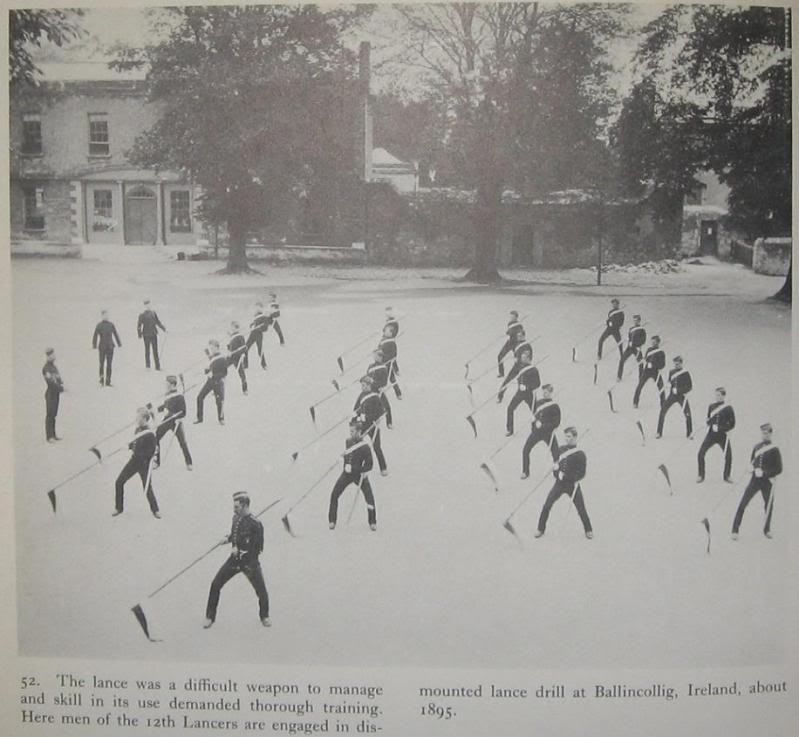
And a few poor quality images from Navy and Army Illustrated Volume 1 (1895) which show a demonstration of various sword, lance, and bayonet demonstrations.
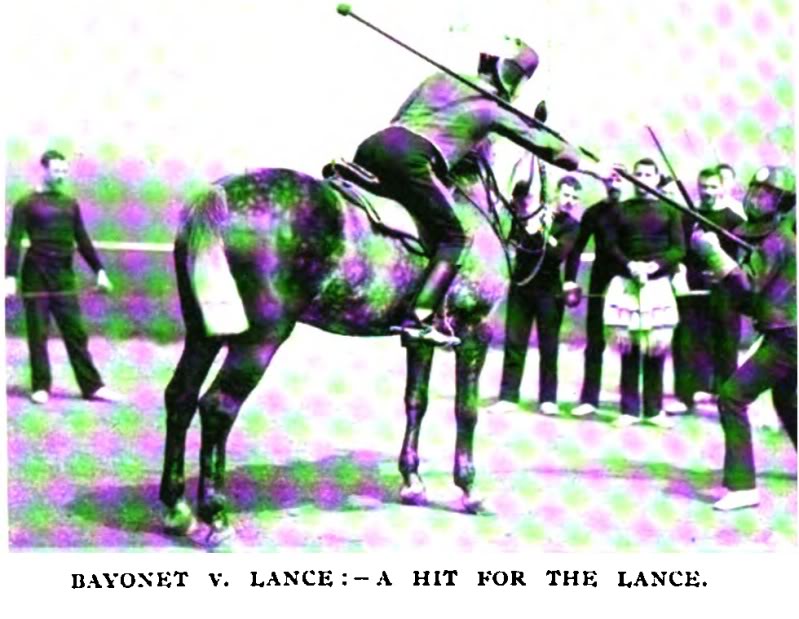
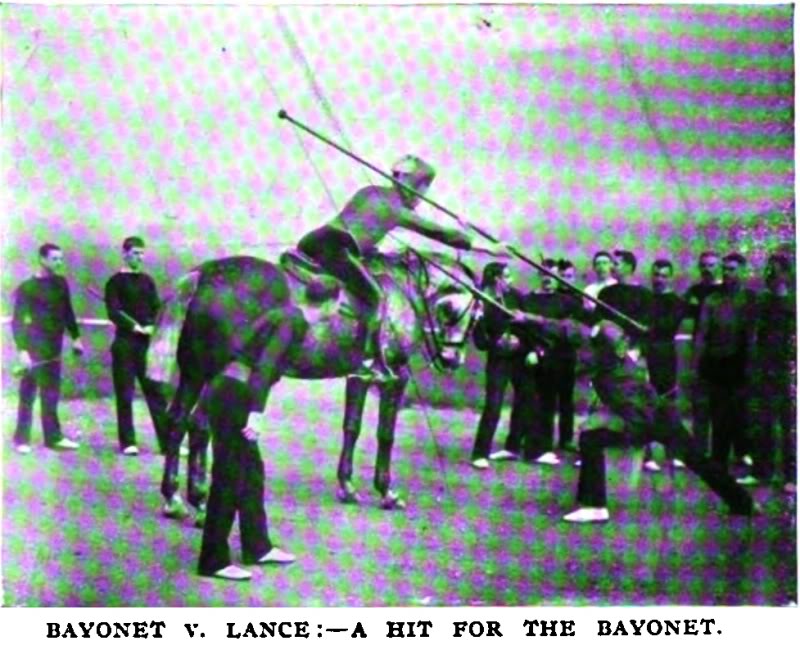
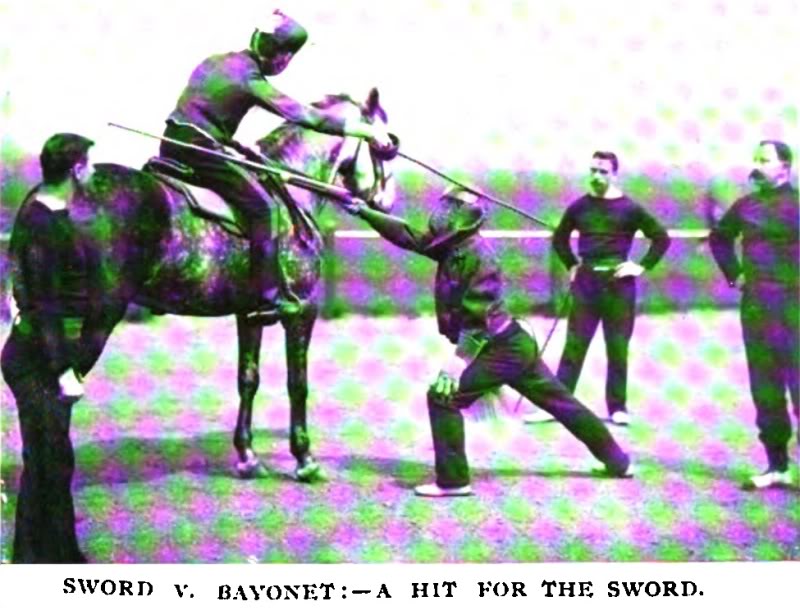
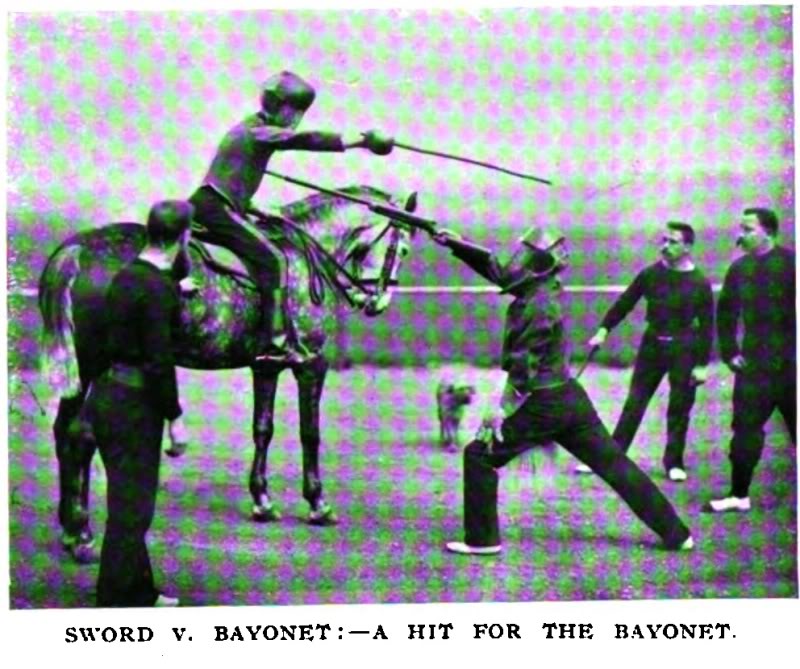
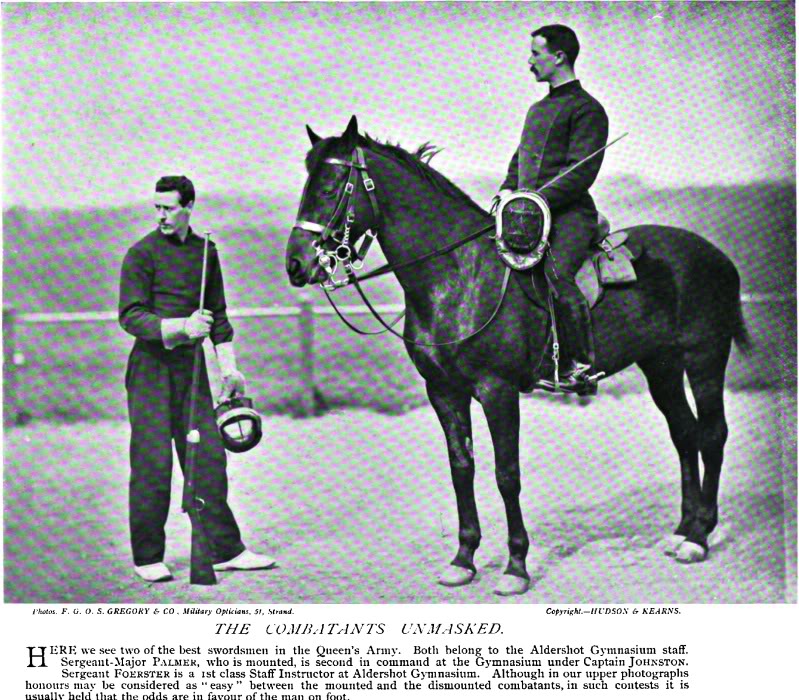
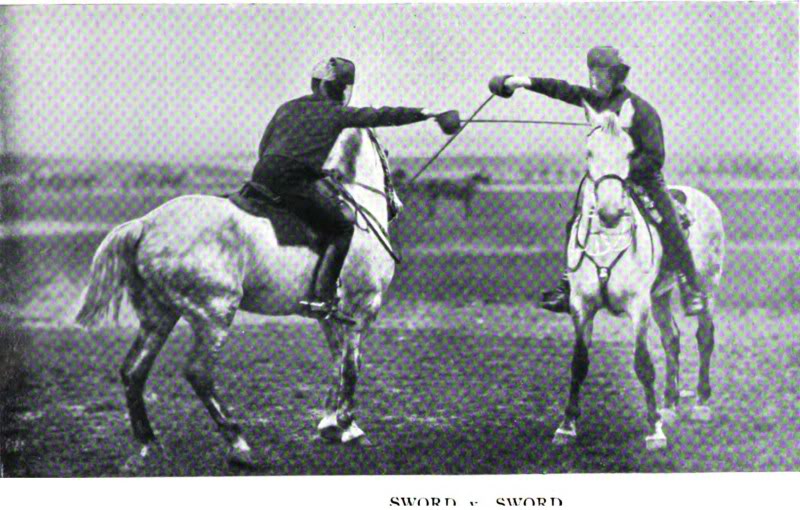
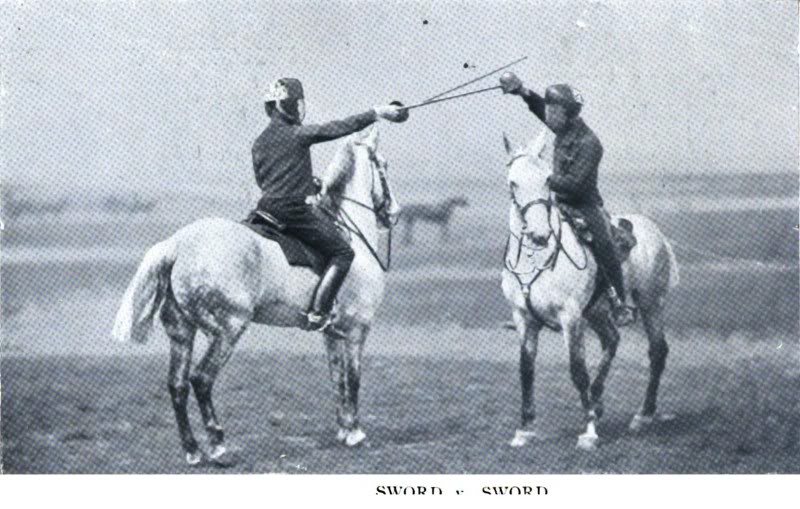
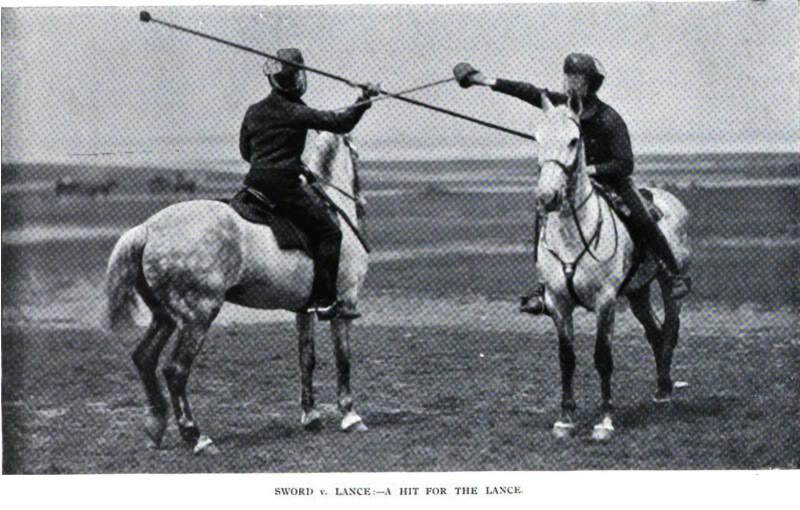
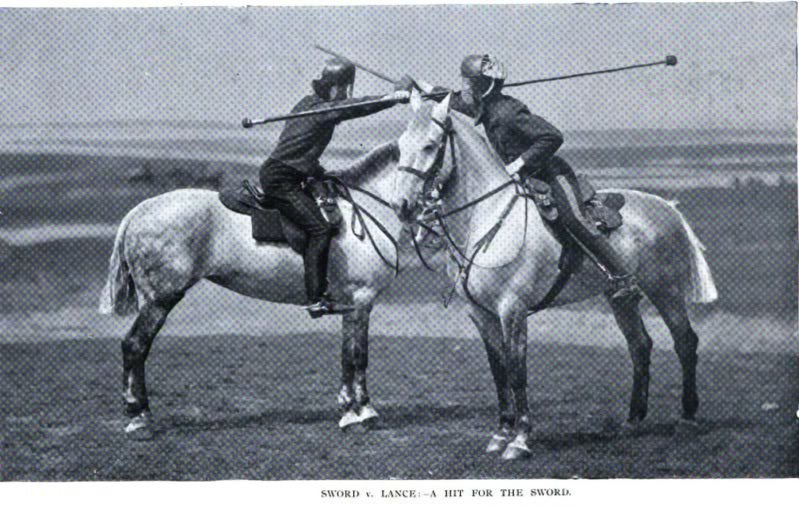

Unknown British Cavalry Lance
Difference Between Cavalry Lances and Boarding Pikes (with some great schematics and measurements of British lances)
Not late 19th century, but maybe of interest Instructions for the sword, carbine, pistol, and lance exercise. (1864)
And from 1890, "The Resurrection of the Lance" by G.J. Younghusband.
And here are a few late 19th century images:
From The Victorian Army in Photographs by David Clammer

And a few poor quality images from Navy and Army Illustrated Volume 1 (1895) which show a demonstration of various sword, lance, and bayonet demonstrations.










one thing i never got about 19th century lancers paticularly napoleonic era.. is that a common remark ive heard (mostly through the sharpe novels) is that, lancers were often extremely vulnerable to sword cavalry 'once you get past the lance point its alot like killing rabbits' it almost makes me think napoleonic lancers didnt HAVE swords as sideams..
| William P wrote: |
| one thing i never got about 19th century lancers paticularly napoleonic era.. is that a common remark ive heard (mostly through the sharpe novels) is that, lancers were often extremely vulnerable to sword cavalry 'once you get past the lance point its alot like killing rabbits' it almost makes me think napoleonic lancers didnt HAVE swords as sideams.. |
The tricky bit is to get past the lance point without being turned into a kebab in the first place. Patton explains how to do this in his Sabre Exercise (1914) (see: http://www.pattonhq.com/saber.html - scroll down to 'Parrying the lance'). Once past his point the lancer has no time to do much to defend himself but, as Patton has it, the swordsman needs to be fast and know what to do or things will turn out badly.
Once things get to a close quarters melee then the lance is certainly a clumsy weapon (see: http://www.bbc.co.uk/history/worldwars/wwone/firstshot_01.shtml - scroll down to 'Opening salvos') but even so I would think that dropping one perfectly serviceable weapon and transitioning to another takes discipline and training (and a healthy slice of courage), even if you have the chance.
Neil.
Anyway, back on topic.
You might already have this but , from the Illustrated Encyclopaedia of Swords and Sabres (Withers, H. J. S. 2008) here are some measurements (not a great book but it has nice pictures):
British cavalry lance 1840 Pattern: OL = 109"
British cavalry lance 1846 Pattern: OL = 108.3" (head and langets = 47.1")
British cavalry lance 1868 Pattern: OL = 81.5"
British cavalry lance 1885 Pattern: OL = 108.3"
British practice cavalry lance circa 1890: OL = 109"
Neil.
You might already have this but , from the Illustrated Encyclopaedia of Swords and Sabres (Withers, H. J. S. 2008) here are some measurements (not a great book but it has nice pictures):
British cavalry lance 1840 Pattern: OL = 109"
British cavalry lance 1846 Pattern: OL = 108.3" (head and langets = 47.1")
British cavalry lance 1868 Pattern: OL = 81.5"
British cavalry lance 1885 Pattern: OL = 108.3"
British practice cavalry lance circa 1890: OL = 109"
Neil.
Here are a few mid-19th century examples from the National Army Museum:
Lance, pattern 1846, 1848.
Lance, pattern 1846, 1848.
Cossack lance, 1854 (c).
Lance, pattern 1846, 1848.
Lance, pattern 1846, 1848.
Cossack lance, 1854 (c).
Here's a nice article
http://napoleon.org.pl/taktyka/lancaen.php
http://napoleon.org.pl/taktyka/lancaen.php
i photographed some ww1 russian cossack lances some time ago in the arsenal of vienna (army history museum).
the photos are not too great but you get the point.
 Attachment: 136.8 KB
Attachment: 136.8 KB
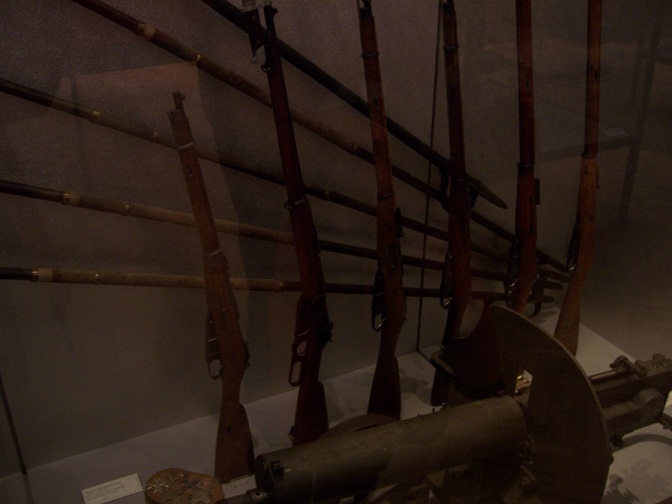
 Attachment: 139.42 KB
Attachment: 139.42 KB
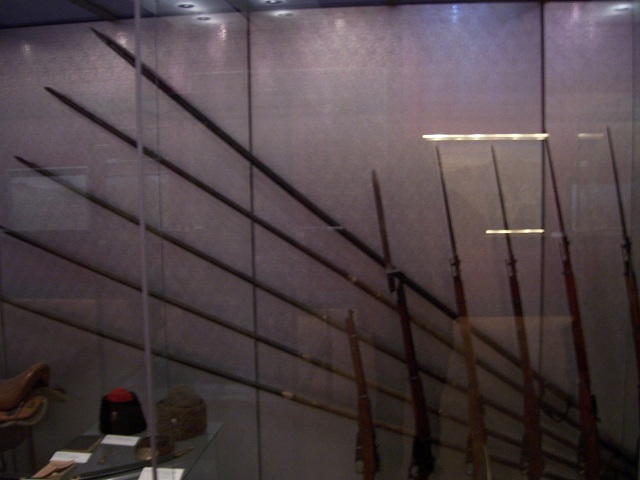
the photos are not too great but you get the point.


| M Hermes wrote: |
| Here's a nice article
http://napoleon.org.pl/taktyka/lancaen.php |
Or look at the site of Bolk Antiques. These two lances came out of my collection and are actually a bit shorter (282cm)
http://www.bolk-antiques.nl/index.cfm?page=co...me=Antique Arms and Armour
I came across this site a few months ago:
http://angloboerwarmuseum.com/Boer20c_techofwar_lance.html
Danny
http://angloboerwarmuseum.com/Boer20c_techofwar_lance.html
Danny
Thank you for all of the replies!
This is exactly the sort of information I was looking for.
This is exactly the sort of information I was looking for.
Are there any British manuals for sabre and lance exercises closer in date to WWI? Or would one have to look at (if any could be found) English translations other manuals?
The one's already supplied in this thread are pretty informative, but would exercises have remained the same for that much from the late 19th to early 20th centuries?
The one's already supplied in this thread are pretty informative, but would exercises have remained the same for that much from the late 19th to early 20th centuries?
I too am confused by this lance vs. saber dichotomy. From classical times through the middle ages and later, lancers always carried a sword as a sidearm, in case their lances broke or the enemy got too close. In the 19th century, though, the argument seemed to be between carrying one or the other. Carrying both at the same time makes sense.
Also, why were 19th century lances so short? Considering that they were around just 9 ft., and that they are generally depicted as being held around the middle rather than couched, they could barely clear the horse's head, and in those photos they have no reach advantage over the bayonet. Seems like an extra yard or so of length, plus couching, would've let lancers charge pretty much anyone head on and impale them before the lancers were within reach. A quick-moving lancer charging a sword-armed horseman head on with a 12 or 15-ft couched lance would have had a huge advantage, and if he thrust his lance, he'd have a reach advantage over a footman with a bayonet on a rifle, too.
The only drawback I can think of is that it would've taken extra training to master a long lance, which would be a problem in an army of horsemen trained by the state. But if they had the lancers play pig-sticking or tent-pegging in their spare time, and if the lances were a bit thinner (they would only be hitting soft, unarmored men, anyway), it should've been doable.
Also, why were 19th century lances so short? Considering that they were around just 9 ft., and that they are generally depicted as being held around the middle rather than couched, they could barely clear the horse's head, and in those photos they have no reach advantage over the bayonet. Seems like an extra yard or so of length, plus couching, would've let lancers charge pretty much anyone head on and impale them before the lancers were within reach. A quick-moving lancer charging a sword-armed horseman head on with a 12 or 15-ft couched lance would have had a huge advantage, and if he thrust his lance, he'd have a reach advantage over a footman with a bayonet on a rifle, too.
The only drawback I can think of is that it would've taken extra training to master a long lance, which would be a problem in an army of horsemen trained by the state. But if they had the lancers play pig-sticking or tent-pegging in their spare time, and if the lances were a bit thinner (they would only be hitting soft, unarmored men, anyway), it should've been doable.
| Michael Wiethop wrote: |
| I too am confused by this lance vs. saber dichotomy. From classical times through the middle ages and later, lancers always carried a sword as a sidearm, in case their lances broke or the enemy got too close. In the 19th century, though, the argument seemed to be between carrying one or the other. Carrying both at the same time makes sense.
Also, why were 19th century lances so short? Considering that they were around just 9 ft., and that they are generally depicted as being held around the middle rather than couched, they could barely clear the horse's head, and in those photos they have no reach advantage over the bayonet. Seems like an extra yard or so of length, plus couching, would've let lancers charge pretty much anyone head on and impale them before the lancers were within reach. A quick-moving lancer charging a sword-armed horseman head on with a 12 or 15-ft couched lance would have had a huge advantage, and if he thrust his lance, he'd have a reach advantage over a footman with a bayonet on a rifle, too. The only drawback I can think of is that it would've taken extra training to master a long lance, which would be a problem in an army of horsemen trained by the state. But if they had the lancers play pig-sticking or tent-pegging in their spare time, and if the lances were a bit thinner (they would only be hitting soft, unarmored men, anyway), it should've been doable. |
couching makes it harder for lances to be retrieved and limits the variety of attacks with their weapon. Also your bayonets argument makes little sense because by that time, most commanders that charging rifle armed infantry line would be suicidal because there is a gun behind that bayonet maybe cannon and later machine guns as well. There were probably only used to quickly attack people who were running away in order to prevent the opposing army from retreating or scouting the enemy position . Also the longer the lance is, the harder it is to maneuver around and say stab one guy, pull out the lance, shift it above and on the other side of the horse and stab another. Also it makes it harder to store and carry over long distances, which was a big priority becuase in the 19th century, especially the late 19th century, the workhorses of any army were atrillery pieces and there supplys, rifles and their supplies, etc.
Maybe I'm being extremely nieve - but all these cavalry lance exercises seem to be missing one essential point (pardon the pun) . Of course the main target is your opponent - normally considered another cavalryman. But I've yet to see a manual that even mentions another obvious target - his mount. Was the horse considered out of bounds / ungentlemanly ? ( as if war ever *was* 'gentlemanly) Take down the horse - and your opponent is just floundering around for a while trying to get out of the mess and fairly easy target.
Again .. infantry vs cavalry. Why aren't they taught .. shoot the horses as cavalry charges?. Don't let them GET to hand to hand ranges ?
Misplaced "Chivalry?? or sheer stupidity ?
Again .. infantry vs cavalry. Why aren't they taught .. shoot the horses as cavalry charges?. Don't let them GET to hand to hand ranges ?
Misplaced "Chivalry?? or sheer stupidity ?
| Michael Wiethop wrote: |
| I too am confused by this lance vs. saber dichotomy. From classical times through the middle ages and later, lancers always carried a sword as a sidearm, in case their lances broke or the enemy got too close. In the 19th century, though, the argument seemed to be between carrying one or the other. Carrying both at the same time makes sense. |
They did carry both.
| Ralph Grinly wrote: |
| Maybe I'm being extremely nieve - but all these cavalry lance exercises seem to be missing one essential point (pardon the pun) . Of course the main target is your opponent - normally considered another cavalryman. But I've yet to see a manual that even mentions another obvious target - his mount. Was the horse considered out of bounds / ungentlemanly ? ( as if war ever *was* 'gentlemanly) Take down the horse - and your opponent is just floundering around for a while trying to get out of the mess and fairly easy target.
Again .. infantry vs cavalry. Why aren't they taught .. shoot the horses as cavalry charges?. Don't let them GET to hand to hand ranges ? Misplaced "Chivalry?? or sheer stupidity ? |
Maybe they thought that if you can beat a armed man then stabbing a large unarmed animal would be easy? Also, the training could be teaching the man what to do if you somehow surprised and are unable to aim and fire your rifle without opening yourself up for a stab out cut. Then again, for infranty, the horse could kick them out bite or run over them even if the man doesn't manage to dipatch them so it would seem like antihorse training for infranty would be extremely beneficial.
Some info and images here.
http://www.vikingsword.com/vb/showthread.php?...ight=lance
http://www.vikingsword.com/vb/showthread.php?t=17594
[ Linked Image ]
http://www.vikingsword.com/vb/showthread.php?...ight=lance
http://www.vikingsword.com/vb/showthread.php?t=17594
[ Linked Image ]
| Ralph Grinly wrote: |
| ... I've yet to see a manual that even mentions another obvious target - his mount. |
I think it has to do with that, given their "short" length; if I was to lance an opponents horse he could, in the same moment, lance me.
| Michael Wiethop wrote: |
| A quick-moving lancer charging... with a 12 or 15-ft couched lance would have had a huge... reach advantage over a footman with a bayonet on a rifle... |
But would he have had a reach advantage over a bullet?
From my experimenting (on foot in a stationary "horse stance"), I can do most of the actions they do here with relative ease and lack of practice, but with anything longer or heavier It'd be more difficult or, given a greater length and corresponding weight (even if hollow and counter weighted), impossible.
Page 1 of 2
You cannot post new topics in this forumYou cannot reply to topics in this forum
You cannot edit your posts in this forum
You cannot delete your posts in this forum
You cannot vote in polls in this forum
You cannot attach files in this forum
You can download files in this forum
All contents © Copyright 2003-2006 myArmoury.com — All rights reserved
Discussion forums powered by phpBB © The phpBB Group
Switch to the Full-featured Version of the forum
Discussion forums powered by phpBB © The phpBB Group
Switch to the Full-featured Version of the forum